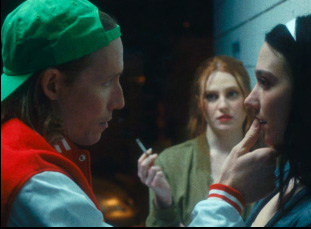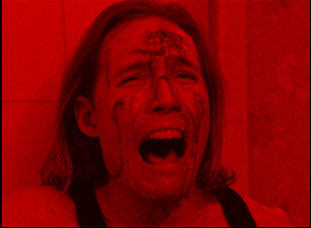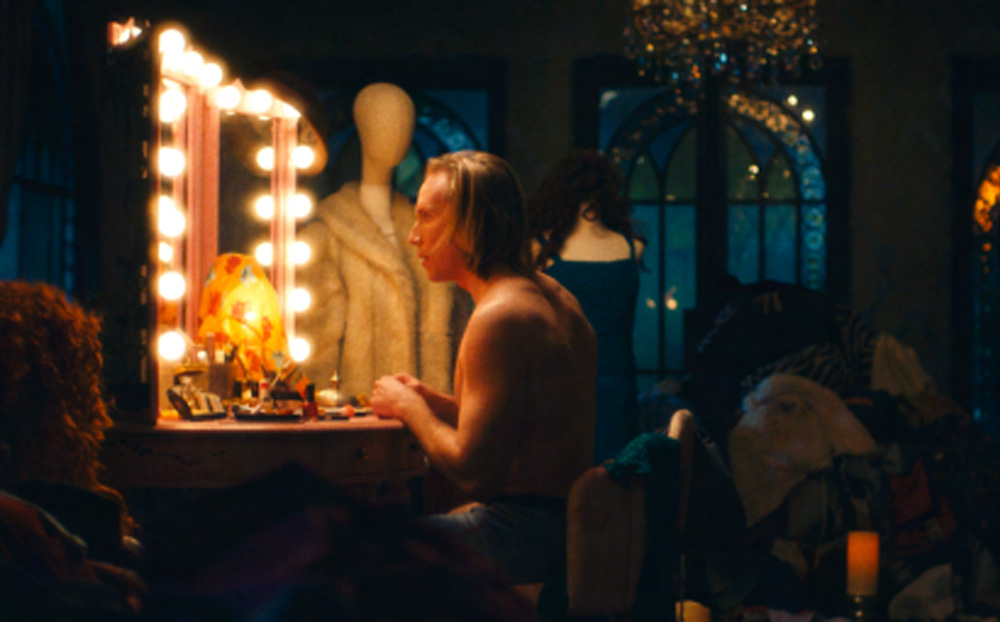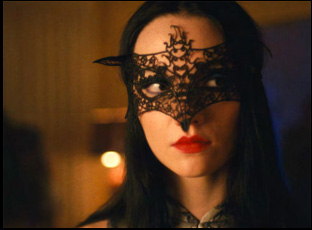One clearly needs to stay vigilant in Blake Simon’s clever and creepy genre tale “Faces” when Judy (Cailyn Rice) arrives in a small town to visit her cousin. Street signs have “Missing” posters affixed to them with a young woman about Judy’s age, but even when an obvious villain appears such as Brad (Ethan Daniel Corbett), a crude jock six years removed from high school who only offers invitation to his house party to her and her friends with the expectation that there will be sex in return, the writer/director considers there could be malevolence elsewhere, following Judy down a dark alley where she hears a voice that sounds uncomfortably close in more ways than one.
It’s a scene that’ll be familiar to horror fans as Judy gingerly walks into the shadows, but when it’s Judy’s own voice that comes back to haunt her – and not as an echo – “Faces” begins twisting and turning tropes of the genre into something original as it tackles the truly terrifying prospect of being uncomfortable in your own skin. Ironically, the genre seems to fit Simon like a glove after directing a series of high-concept sci-fi shorts such as “Labyrinth” and “The Passage” and learning the ropes of large-scale filmmaking as an assistant director on “Ford v. Ferrari” and an associate producer on “Indiana Jones and the Dial of Destiny.” Those chops show when he pulls off a raging kegger to end all others in “Faces,” as Judy makes her way over to Brad’s and in a house of harsh lights and large mirrors, the party evolves into a phantasmagorial evening of self-reflection with the two exchanging a lot more than phone numbers by the end of the night.
With the film premiering this week at Fantasia Fest in Montreal, Simon took the time to talk about his recent dive into horror that includes his previous short “Red Velvet,” pulling off the major set piece of “Faces” and its equally complex performances and potential plans for a feature version.
I had made another short right before this one and it had been years since I made my own thing, but it went really well. We had a great crew and one of the things, especially with any film, but especially indie film, is that it takes a village, it’s such a huge endeavor. I felt so good and comfortable with the team that I [thought], I want to keep this momentum going, so we were in post on that project and I had written “Faces” and I called up the producers of the previous short and I was just like, “Get everyone back, we’re going to do it again.” That previous short was kind of the toe-dip into horror, and when it went well, I thought, “I want to take a bigger swing.”
You would always have a home at Fantasia Fest, but it looked like from your earlier shorts you were leaning more towards a career in sci-fi. How did horror start to have an appeal?
It’s funny you ask that. My transition into horror was a surprise even to me, to be honest. I was not the kid growing up watching horror and obsessed with it and arguing with people about “Jason X” versus “Halloween 15.” I was actually afraid of horror and I didn’t start even watching horror movies until my early twenties, and that was only because I started to have a couple ideas for horror movies, so I thought I should not be making something without at least educating myself on the genre. Then I watched all the classics and by the end of it, I was like, “Okay, I get it.” But it was years I actually put off doing horror because of my own fear and I actually think that that is something that might make my approach different is that I’m not trying to necessarily pay homage to things that inspired me as a kid so much as I feel I’m just really dialed into what frightens me. Hopefully, that comes across and now I feel so at home in the genre. I don’t think there’s any going back.
The film really does get at something real in what’s terrifying about it. How did the story come about?
The search for identity is something that society, rightfully so, is so in support of — finding ourselves, as we should be. It’s taken too long to get here. But one thing that I was witnessing with many of the people around me is that the quarterlife crisis is such a real thing. Scarier than it being a real thing was that it was something no one was really talking about, and it was really interesting was how everyone questions parts of [their life], whether it’s career or personal lives and there’s always something you’re like, “What can I be doing better?” Everyone has those questions, and sometimes those questions are bigger and sometimes they’re smaller, but people I’ve known for a very long time would do things or change things about themselves in a really spontaneous way, which was out of character. It wasn’t like the person with all the cool tattoos got another tattoo. It’d be the person who’s like, “I’m never getting a tattoo,” and suddenly they show up to a gathering with a bunch of stuff, so [you think] what’s going on underneath here that we’re not talking about?
I was seeing this with all like everywhere I was going in different ways, shapes and forms, and to me, that was really scary. It was also relatable. It was this idea that like there’s this thing inside of us that can fuel this desire for change. That’s often such a good thing, but there felt like there was this dark side of it that wasn’t being talked about and I wanted to explore that.
You’ve got a pair of chameleonic actors to play the parts. What sold you on Cailyn Rice and Ethan Daniel Corbett to play these parts?
All movies live or die on your cast, and “Faces” especially so. I hadn’t known Cailyn or Ethan beforehand, but without giving away too many spoilers, there [have to be] a lot of similarities in their performances, but also some differences, so when we were doing auditions, we had specific sides for the actors that would highlight whether they could handle the varying sides and opposite ends of the spectrum of what each of them had to do. They both pulled it off with flying colors. I remember Cailyn has a lot of physicality in her performance, and it was very funny in her audition. She used to be a dancer before she went into acting, and we had asked her in the audition, what kind of dance did you do? And her answer was, “Witchy shit,” which we got a kick out of and immediately I thought I can do something with that. [laughs]
And then Ethan, a lot of people send in tapes and audition live and many of those tapes were a couple of minutes. Ethan’s was almost 10 minutes and it was just him living in the space, almost no dialogue. Myself and the producers watching that were just completely rapt for 10 minutes and could not take our eyes off. And then I got the two of them together once we cast them, because [we told them], “You guys have a lot of similar things ahead of you,” and they were both extremely excited to feed off the other’s performance. I made a point of having them both on set for the vanity room scenes to see the other’s performance so that they were very much in sync when handling those scenes.

Of course, there’s a lot you could like tear apart with that. First of all, it’s a horror film, so in terms of tonality, I am referencing a lot of the classic ’80s slasher era [films]. There’s a ton of Carpenter, Wes Craven and Brian De Palma, but what often what I tell people with “Faces” is that the start of this film, you feel like, “Oh, we’re about to watch ‘Halloween,’” and by the end of the film, you’re watching a very different movie. It was all set up through the guise of a modern twist on an 80s slasher, because obviously the film is modern day, [which] I think a lot of a lot of horror avoids because of technology when in some ways it’s inherently uncinematic.
But because the film is about identity and discovery, and so much of identity is looking at what’s come before you and finding what you want to riff off of, it felt like a natural place to inject all kinds of things and make the film a very [much like a] collage. I didn’t want this to feel like this is such a 2024 movie. I wanted to feel like it’s pulling from all these different things, just like the characters are pulling from all these different things around them.
What was it like to film the house party? That’s incredibly hard to pull off for any film, let alone a short.
It was very difficult. I was very lucky to get that house. A good friend of mine was able to help provide it to us, and all of the scenes that take place in that house are actually in the house — the bedroom, the bathroom, the walk into the party — none of it’s cheated from a different location. That made it tricky because you’re staging lights and setting up the next scene and there was nowhere to go that wasn’t going to be on camera at some point. You’ve got people shoved in rooms because it’s the only corner that we’re not filming. And then with the party in the background, you want to sell that as real, so you call in a lot of favors, [say] “come party with us for a little bit and you’ll be in the background of every shot. You’re going to be out of focus and in this shot, your hair is up and in this shot, your hair is down. We won’t recognize you.” But it was very scrappy, DIY type filmmaking where with next to no money, we needed to make this feel like a fully lived in party, and the way I construct the shot list is to follow that character as she walks through it, which meant you can’t just bury it all in cuts. There is a level you need to get everyone in front of the camera for these big sweeping shots, and our producer and first AD Liz Holland was instrumental in just getting everyone there. It was huge.
Did you know how much you could complete the experience with sound?
Yes, but not necessarily for this film in particular. Sound is just a huge element for me in anything I do and I can be a bit neurotic when it comes to sound, more so than a lot of my friends who direct. Matt Pendleton, our post supervisor, really put up with me. Our entire process was hilarious because he’s just so good that every time he’d send me something, it would actually be really good, and I’d be like, “it’s amazing. It’s perfect. Just a couple of things. And then I’d send him pages of stuff.” But I think sound is highly overlooked in indie film. Everyone’s hyper concerned about what camera you can shoot on and how expensive your lenses are and sound often is, if not forgotten, given the least amount of attention and I think it is it is a character in the film, especially a film like this that is so cerebral and tonal that it wouldn’t be the same movie without it.

That’s true, it’s a proof of concept, but it is sort of backwards because a lot of proof of concepts are someone who writes a feature and they’re like, “Oh, I’m going to do this scene from it” and that’s great when that works. But I’ve always struggled with that idea because whenever I tell a story, even in a short film, I feel the need to have like a complete narrative. So “Faces” actually started as what it is. But after making many shorts, it’s the only time I made a short where as soon as it was done, it was so clear to me that there’s so much more story to tell here.
As far as what I would take into the future, one of the biggest things I learned from the short wason the page, I didn’t know if everyone would understand what what they’re watching and and who were watching because there’s no dialogue in this story to refer to certain characters by name or description. It’s all visual. I truly was nervous when I was making the short that people would be confused, but every single person got it with zero confusion. It works both on an intellectual and emotional level for everyone who’s seen it, so the biggest lesson was really just to trust the audience and the reminder that this is a visual medium. I had never attempted to do that so much in the short and that scared me. Then when it paid off, it was really validating both just for the film and for faith in the audience and faith in my own visual storytelling.
What’s it like to get the film to Fantasia?
We’re very excited. Fantasia was truly a dream festival for us and Mitch Davis, the artistic director of the festival, has been such a huge supporter and believer in the film. He let us know a while ago that it got in and he wrote me directly the most beautiful message. I already feel so much love and support from the festival and we truly couldn’t be happier to be world premiering it anywhere but Fantasia and I look forward to wherever we screen the rest of the year. I’m just looking forward to having a good time and sharing the film with more people.
“Faces” will screen at Fantasia Fest on July 31st as part of the Small Gauge Trauma shorts program at 9:30 pm at the Salle J.A. De Seve.





